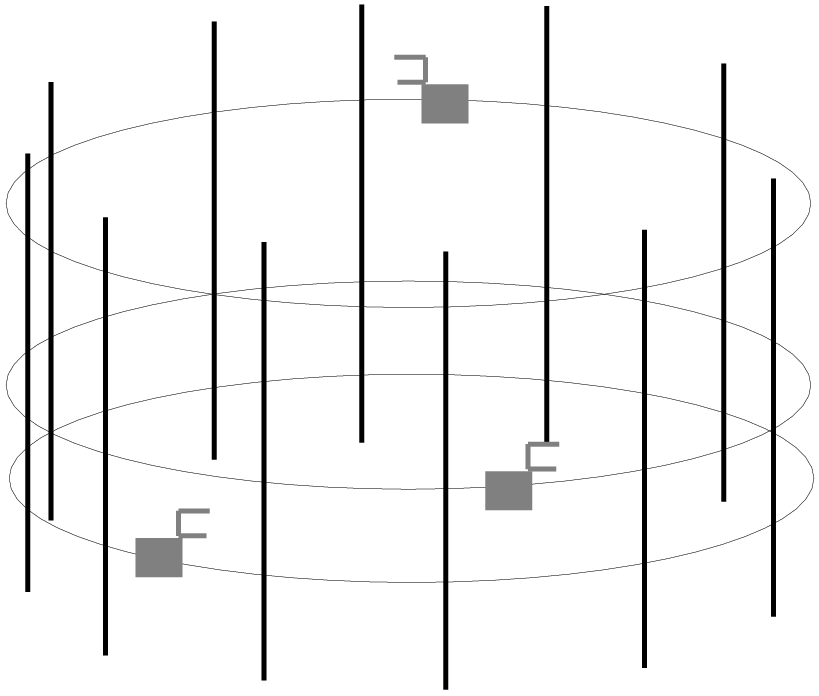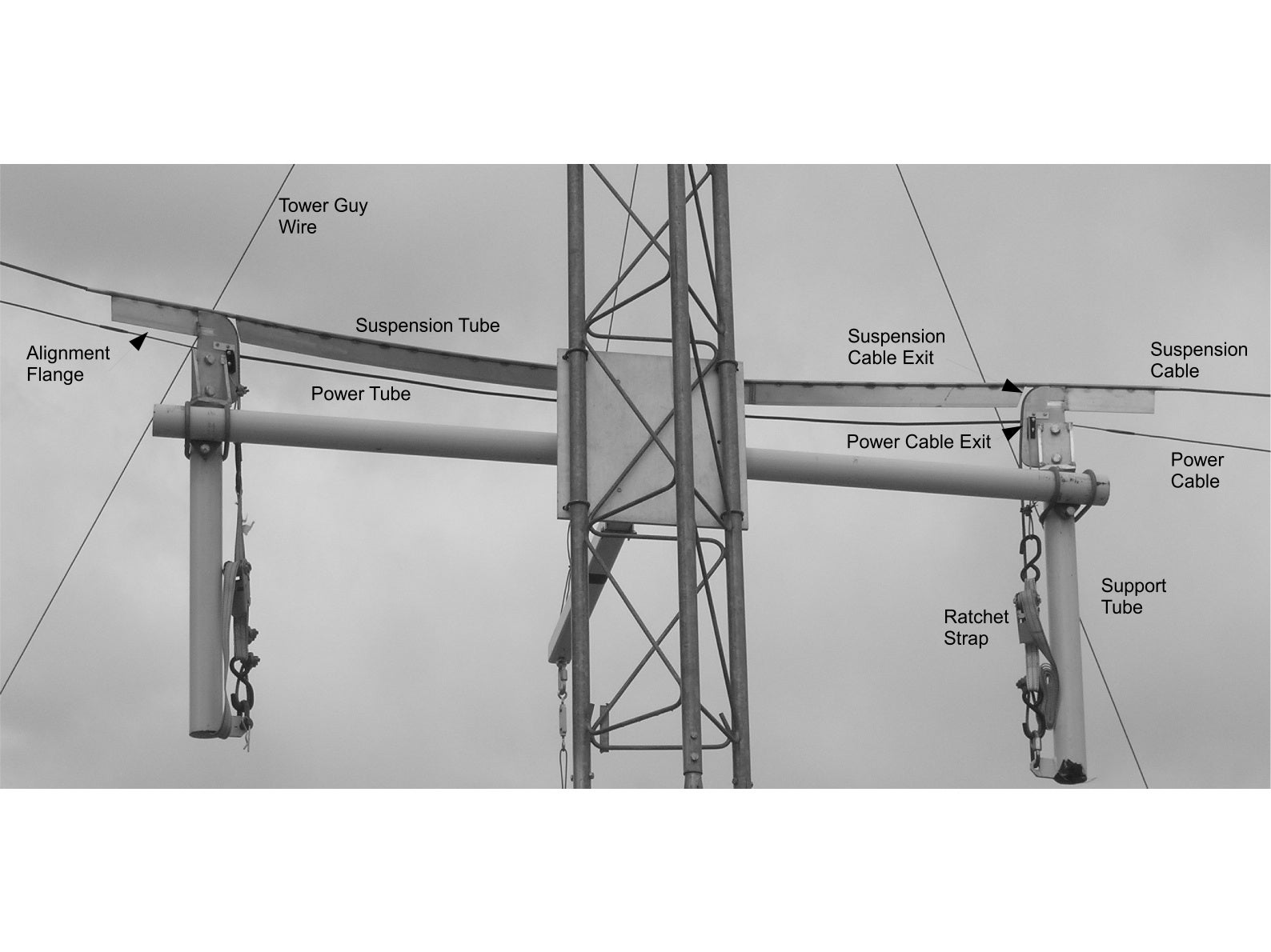We are now on the second version of track, though both were developed on the same principle. Cables are supported by "turns" attached to Rohn towers. The turns consist of a pair of plates that attach to the tower using U-bolts. The plates can rotate in "yaw" for a first-level adjustment to minimize the angles of the approaching cables. Attached (using more U-bolts) to the rotating plate are split saddles to hold a cross-tube. Attached to the cross-tube, using cast 90-degree clamps, are vertical support tubes with "noses" on the top. Cables enter one side of the nose, are guided downwards and secured (using saddles to make a loop and ratchet straps that are attached to the vertical tubes). The back side of the nose has a threaded bolt to which formed turns (made of bent tubing welded to a guide band) are attached. An extra support tube can attach to the middle of the guide bands to prevent bending. In the second version, 2.5" tubing was replaced by 2" tubing, the noses were lengthed and made separate from the vertical tubes, the guide band supports were changed, the bend radius of the turns was increased from 5' to 6', etc.
| Year | Location | Total length (m) | Number of towers (tower sections) | Number of "turns" | Total run time |
|---|---|---|---|---|---|
| various | FLAB | ~60 | 3 (5) | 4 (2x 180) | n/a |
| 2007 | Niwot Ridge/Como Creek | 240 | 11 (22) | 15 (2x 180) | 56 hr |
| 2009 | Niwot Ridge/Flux towers | 360 | 15 (28 [one tower was CU mini]) | 25 (1x 180) | 41 hr |
| 2012-2016 | BAO | 200 | 6 (18) | 10 (straight; 2x 180) | 4+2+6=12 hr |
All of the components of the turns (with the exception of the straps and clamps) were made by NCAR/EOL/DFS.
Layout
I have now built 4 different tracks. Only one track (BAO) sampled at only one height. The others had at least one segment where the return path was at a different height along the same set of towers. The trolley climbs the cable pretty well. An incline of 2m gain per 20m tower spacing works.
One optimal sampling strategy to enclose a volume would use multiple trolleys to sample multiple heights and would use a circle to enclose the maximum area with a fixed amount of track.

Installation
Installation of the track consists of: selecting the location, site preparation (clearing a path), erecting the towers, attaching the plates, building the turns (on a temporary plate installed at a convenient height), raising the turns to the final height, stringing the cables and roughly securing them, coarse adjustment of the turns, cable tensioning, fine adjustment of the turns, and finally data system installation.
A few things need to be kept in mind when erecting the towers. The azimuth angle of the tower should be set to split the azimuth angles of the approaching cable runs. It is possible to use the 2" support tubes in non-standard configurations to adjust if this is not possible. The tower and "up-down" guy wires need to be attached so as not to interfere with trolley motion. (This happens more than one would think!) We now use ratchet straps for quick tensioning of the guy wires and have successfully used web straps around tree bases for tower anchor points.
Raising the turns is done with a simple rope and pulley system, though it can be awkward to find the correct balance point to pull up these heavy metal pieces.
Stringing the cables is the most frustrating part of set-up. The braided metal cables have to be inserted through tubing that is essentially press-fit. If even one strand of the braid becomes unwound, it is impossible to do this. Naturally, this is done with arms outstretched while hanging out from a tower. It sometimes is necessary to recut the ends multiple times, which itself is difficult since the cutter is large and has to be braced on one end (usually against the tower) to get enough leverage to cut the 1/4" stainless cable. Obviously, the cable weight is trying to pull the cable out of the nose as well. The weight can be mitigated for the most part by first attaching the cable to the nose using a cam clamp.
The copper cable will not bend easily, so a short stainless "whip" is used. It is crimped to the end of the copper using brass (formerly copper) sleeves. One of Kurt's crimping tools works pretty well, but needs to be used many (6) times to ensure that the cable won't slip. (In the very first TRAM track, we soldered these whips, using machined copper splices. This was a lot of work and involves bringing a torch into the field.) Note that setting the copper cable length is rather critical. The sleeves must always be clear of the power noses to avoid damaging them. However, once the support cables are tensioned, the distance between the power noses can change. Again, cutting the copper to length must be done when on the tower, though the end can be dropped to the ground while crimping on the whip.
The whip can be easier to insert by unscrewing its "nose" from the rest of the assembly. However, this entails also keeping track of its 2 mounting screws, a thin insulating plastic plate, and two insulating hole sleeves. Usually, I only partially unscrew the nose to keep all of these pieces attached.
To keep my sanity, I use a system that one side of the turn has both the power and support cables attached directly to the down-tubes and the other side has the ratchet straps, though this does mean that every tower must be climbed in order to tension the cables.
The only issue in coarse tensioning of the support cable is that there isn't much play in the length of ratchet strap. The loop (formed using saddles) must be kept close to the nose and sometimes must be reformed. In some cases, I have removed the fixed S-hook on the ratchet strap and directly attached the ratchet to the downtube, but this skews the ratchet from being centered. This could be improved. Note that up- and down-guying of the middle turn supports is needed to oppose the support cable tension. When multiple turns are on the same side, I used one guy between them (as the top-guy for the bottom turn and the bottom-guy for the top turn).
Inventory
I'll have to fill in the exact numbers, but I now should have 25 turns (plates, tubes, clamps, pairs of noses, ratchet straps, etc.). Obviously, the angles of the turns change with each track, so it is expected that more of these pieces would have to be built for a new track. I once estimated that complete turns cost about $2000 each to make (mostly the noses), but the bends should be less than $500.
I purchased quantity 51 10' Rohn 25-G tower sections (one [currently used in the "swamp" test track] has a property tag on it), along with 20? normal base plates and 5? tilting base plates. I should have enough ratchet straps to guy these.
So far, I've recycled the 1/4" stainless steel cable originally used to guy the CASES99 scaffolding tower for use as suspension cable. As these lengths are cut for each new track, I will eventually need to purchase more.
I once acquired a bunch of surplus lengths of PAM 1/8" stainless cable for tower guying and turn up/down guying.
I purchased a spool of copper power cable, though it isn't as finely stranded as what we first used.
I also chew through copper tubing for various purposes, but still am using the first batch of tubing used to make the first (power) turns. Eventually, I'll need to get more.
Brass tubing for power cable splices I've purchased as needed from McGuckins.
One issue is the cast aluminum clamps for 2" tubing. These are hard to deal with since the dimension is essentially a press fit. "Spreading" them to fit has cracked the casting on several clamps. I bought some scaffolding clamps that are easier to use, but even ones advertised as "true 2 inch" actually are only 1.9" and will not work with our tubing. The best solution would be to convert to using 1.5" pipe, for which clamps and other hardware are readily available, though aluminum pipe is not as available and steel pipe is heavy. Also, several components (e.g. swivel plates, nose supports, and turn supports) would have to be rebuilt.
To avoid U-bolts (which are problematic to align 4-at-a-time for the swivel plates), we could convert to truss half cell clamps (101), simply by drilling another 4 holes (or not!) on the swivel plates in the middle of each of the U-bolt holes.
Addendum, 2016
Dismantling of the BAO track was rushed to accomodate the rapid schedule of decomissioning of the BAO site. Also, effort was never put into completely reorganizing the TRAM trailer after its use during SOAS. When time permits, the trailer and its contents need to be thoroughly cleaned.
